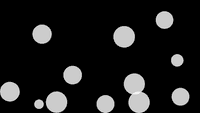Examples+
Brownian motion
Recording random movement as a continuous line.
Highlighted Features
/**
* Brownian motion.
*
* Recording random movement as a continuous line.
*/
int num = 2000;
int range = 6;
float[] ax = new float[num];
float[] ay = new float[num];
void setup()
{
size(640, 360);
for(int i = 0; i < num; i++) {
ax[i] = width/2;
ay[i] = height/2;
}
frameRate(30);
}
void draw()
{
background(51);
// Shift all elements 1 place to the left
for(int i = 1; i < num; i++) {
ax[i-1] = ax[i];
ay[i-1] = ay[i];
}
// Put a new value at the end of the array
ax[num-1] += random(-range, range);
ay[num-1] += random(-range, range);
// Constrain all points to the screen
ax[num-1] = constrain(ax[num-1], 0, width);
ay[num-1] = constrain(ay[num-1], 0, height);
// Draw a line connecting the points
for(int i=1; i<num; i++) {
float val = float(i)/num * 204.0 + 51;
stroke(val);
line(ax[i-1], ay[i-1], ax[i], ay[i]);
}
}
Related Examples
This example is for Processing 4+. If you have a previous version, use the examples included with your software. If you see any errors or have suggestions, please let us know.





